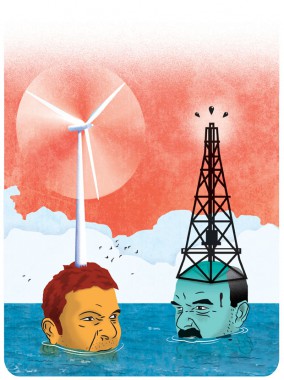The Southeast is at a crossroads: open up its waters to oil drilling or shift its focus to renewable offshore wind energy. Which way will the political winds blow? Two regional experts offer their insights.
Offshore Oil
Gasoline prices have been rising, spurred by higher demand for crude oil worldwide and instability in the Middle East. We should address this situation by producing more oil here at home, instead of relying heavily on foreign oil imports.
Some opponents of domestic oil production claim that resources in the U.S. are too scarce to make development worthwhile. But a recent study by the energy consulting firm ICF International estimates that development in federal waters offshore of Virginia could produce more than half a billion barrels of oil and more than 2.5 trillion cubic feet of natural gas. Those estimates translate to enough oil to fuel all the cars in Virginia for more than 4 years and enough natural gas to heat all the homes in Virginia for more than 11 years.
Those numbers are probably low, if you consider that original estimates for what experts thought would be produced in the Gulf of Mexico and Alaska were greatly underestimated. New technology available today can provide better estimates of resources that exist in the Atlantic Outer Continental Shelf. Unfortunately, the only data available now is from seismic testing and exploratory actions taken 30 years ago and through outdated methods. (Think of a Polaroid snapshot compared to high resolution x-rays.)
Recently, the Obama administration announced it would consider allowing new seismic and geological/geophysical testing off the Atlantic Outer Continental Shelf. This is an encouraging step, but we should note that the federal government does not generate this data. Seismic companies do. And they generally do that on a speculative basis, hoping to sell the data to companies looking to purchase leases in an area. With no lease sale scheduled anywhere off the Atlantic seaboard now, and thus no potential customers, seismic companies have little incentive to gather new data.
We can and should improve our energy efficiency and develop more alternative and renewable energy sources; the U.S. oil and natural gas industries are leaders in both areas. Our own government experts say we will continue to rely on oil and natural gas for a majority of our energy for decades to come. Ignoring the benefits (job creation, energy security, and deficit reduction) of safely developing our vast domestic reserves of oil and natural gas will make our current energy challenge even greater.
Michael Ward is the executive director of the Virginia Petroleum Council.
Offshore Wind
I firmly believe in developing offshore wind energy, so it might surprise you that I started my career at one of the largest oil companies in the world, drilling offshore wells in the United States and Africa. I’ve always been a numbers geek, and with two engineering degrees and an MBA, I’m also a fiend for data. My transition into green energy entrepreneur didn’t spring from vague hippie ideals but from time in the field and from crunching numbers. So, why do I support offshore wind?
First, some common-sense basics: offshore wind energy is clean, domestically available, and won’t run out. The machines used to harness wind cost money, but wind will always be free. This makes wind a stably priced energy source, whereas the cost of coal, oil, or gas is hard to predict over two years, let alone twenty.
Let’s put these benefits into perspective. Within fifty miles of the North Carolina coast are a whopping 297,000 megawatts of untapped wind energy. Even providing for restrictions such as shipping lanes or paths for migrating seabirds, 55,000 megawatts are still available. This amount alone can provide enough power to cover over 130% of North Carolina’s electricity demand. Just 8,000 megawatts would supply about 20% of that demand.
All of this potential translates into jobs—lots of them. Remember those 8,000 offshore megawatts? Estimates from the National Renewable Energy Labs (NREL) predict that this amount of development would create 33,000 construction jobs and 6,400 permanent operations and maintenance jobs. New Jersey, Delaware, Massachusetts, Maryland, and Rhode Island have already taken aggressive steps to attract this new industry.
Using fossil fuels for energy comes with a host of costs that don’t show up on our monthly bill. But we’re still paying for them—in the public health, environmental, even military sectors. These costs act as a built-in subsidy for fossil fuels, making them appear less expensive than they are. Let’s also note that costs of renewables are trending down while the costs of fossil fuels are trending up.
No energy source is perfect, and all present challenges. I’m not naïve enough to believe that we can or even should eliminate fossil fuel use in my lifetime. But I do believe that we can reduce our dependence on fossil fuels and build a clean energy future. Recognizing the potential of offshore wind energy and other renewables can help make this future possible.
Brian O’Hara is the president of the North Carolina Offshore Wind Coalition.
Join the energetic debate at blueridgeoutdoors.com








